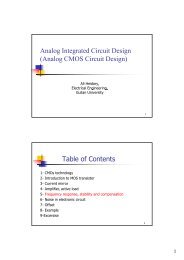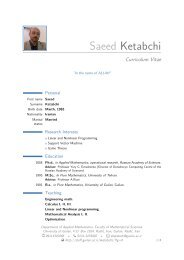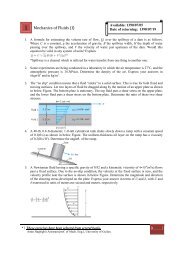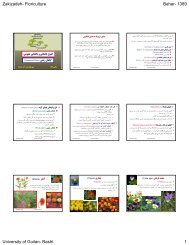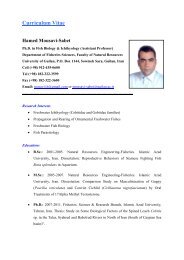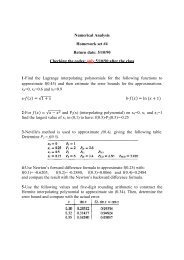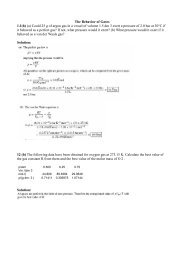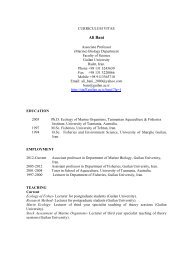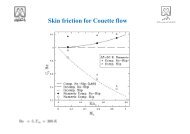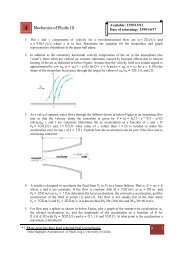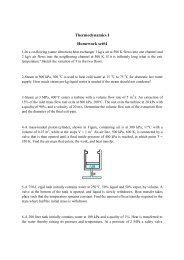Notes ● 211137. Houyuan, “The Case of Ch<strong>in</strong>a,” p. 201.138. Ibid., p. 204.139. Ibid., p. 201.140. Songphan S<strong>in</strong>gkaew and Songyot Chaichana, “The Case of Thailand,” <strong>in</strong>UNCTAD-WHO Jo<strong>in</strong>t Publication, International Trade <strong>in</strong> Health Services,p. 243.141. Ibid., p. 237.142. M. Sarup, Identity, Culture and the Post-Modern World (Ed<strong>in</strong>burgh: Ed<strong>in</strong>burghUniversity Press, 1996), p. 127.143. Nelson H. H. Graburn, “<strong>Tourism</strong>: The Sacred Journey,” cited <strong>in</strong> ValeneSmith, ed., Hosts and Guests, 2nd ed. (Philadelphia: University of PennsylvaniaPress, 1989), p. 33.144. Henderson, “Healthcare <strong>Tourism</strong> <strong>in</strong> Southeast Asia,” p. 117.145. S. Haron and B. Weiler, “Ethnic <strong>Tourism</strong>,” cited <strong>in</strong> Melanie Smith, Issues <strong>in</strong>Cultural <strong>Tourism</strong> (London: Routledge, 2003), p. 117.146. See Gene Grossman and Elhanan Helpman, Innovation and Growth <strong>in</strong> theGlobal Economy; Paul Romer, “Endogenous Technological Change,” Journal ofPolitical Economy 98, no. 5 (1990); and Phillipe Aghion and Peter Howitt,“A Model of Growth Through Creative Destruction,” Econometrica 60, no. 2(1992).147. J. Barro, Determ<strong>in</strong>ants of Economic Growth (Cambridge, MA: MIT Press,1996), p. x.148. Wattana Janjaroen and Siripen Supakankunti, “International Trade <strong>in</strong> HealthServices <strong>in</strong> the Millennium: the Case of Thailand,” <strong>in</strong> WHO, Trade <strong>in</strong> HealthServices, p. 97.149. Francisco Leon, “The Case of the Chilean Health System, 1983–2000,” <strong>in</strong>WHO, Trade <strong>in</strong> Health Services, p. 170.150. Middle East Airl<strong>in</strong>es, Airliban, “Dest<strong>in</strong>ation Lebanon. Health <strong>Tourism</strong>,” www.mea.com.lb/MEA/English/Visitlebanon/Healthtourism, accessed September 30,2005.151. Henderson, “Healthcare <strong>Tourism</strong> <strong>in</strong> Southeast Asia,” p. 116.Chapter 61. Cuba’s efforts to market its pharmaceutical f<strong>in</strong>d<strong>in</strong>gs have been met by greatcommercial (and political) obstacles due to the U.S. trade embargo. Cuba’sstrength lies <strong>in</strong> research, not <strong>in</strong> the market<strong>in</strong>g and know-how required to placetheir products abroad. As a result, it is sett<strong>in</strong>g up jo<strong>in</strong>t venture with partnersthat <strong>in</strong>clude Canadian, German, and Spanish companies. Cuba has licensedTheraCim h-R3 to a German pharmaceutical company to develop the drug forEuropean markets. If it gets regulatory approval, it could become the standarddrug treatment for some cancers <strong>in</strong> Europe. Tom Fawthrop, “Cuba Sells its<strong>Medical</strong> Expertise,” BBC News, www.newsvote.bbc.co.uk/mpapps/pagetools/pr<strong>in</strong>t/news.bbc.co.uk/2/hi/bus<strong>in</strong>ess/3284995.stm, accessed January 4, 2006.
212 ● Notes2. Simonetta Zarrilli, “Identify<strong>in</strong>g a Trade-Negotiation Agenda,” <strong>in</strong> WHO, Trade<strong>in</strong> Health Services: Global, Regional and Country Perspectives (Wash<strong>in</strong>gton, D.C.:Pan American Health Organization, Program on Public Policy and Health,Division of Health and Human Development, 2002), p. 76.3. L<strong>in</strong>da F. Powers, “Leverag<strong>in</strong>g <strong>Medical</strong> <strong>Tourism</strong>: Opportunities and Challengesfor Biotechs Follow People on Health Holiday,” The Scientist 20, no. 3 (2006):p. 79.4. Deepsouth Pack<strong>in</strong>g Co. v. Laitram Corp., 406 U.S. 518 (1972).5. See Patent Law Amendments Act of 1984, Pub. L. No. 98-622, 98 Stat.3383.6. See 35 U.S.C. § 271(f):(1) Whoever without authority supplies or causes to besupplied <strong>in</strong> or from the United States all or a substantial portion of the componentsof a patented <strong>in</strong>vention, where such components are uncomb<strong>in</strong>ed <strong>in</strong> wholeor <strong>in</strong> part, <strong>in</strong> such manner as to actively <strong>in</strong>duce the comb<strong>in</strong>ation of such componentsoutside of the United States <strong>in</strong> a manner that would <strong>in</strong>fr<strong>in</strong>ge the patentif such comb<strong>in</strong>ation occurred with<strong>in</strong> the United States, shall be liable as an<strong>in</strong>fr<strong>in</strong>ger. (2) Whoever without authority supplies or causes to be supplied <strong>in</strong> orfrom the United States any component of a patented <strong>in</strong>vention that is especiallymade or especially adapted for use <strong>in</strong> the <strong>in</strong>vention and not a staple article orcommodity of commerce suitable for substantial non<strong>in</strong>fr<strong>in</strong>g<strong>in</strong>g use, where suchcomponent is uncomb<strong>in</strong>ed <strong>in</strong> whole or <strong>in</strong> part, know<strong>in</strong>g that such componentis so made or adapted and <strong>in</strong>tend<strong>in</strong>g that such component will be comb<strong>in</strong>edoutside of the United States <strong>in</strong> a manner that would <strong>in</strong>fr<strong>in</strong>ge the patent if suchcomb<strong>in</strong>ation occurred with<strong>in</strong> the United States, shall be liable as an <strong>in</strong>fr<strong>in</strong>ger.7. Steven C. Tietsworth, “Export<strong>in</strong>g Software Components—F<strong>in</strong>d<strong>in</strong>g a Role forSoftware <strong>in</strong> 35 U.S.C. § 271(f) Extraterritorial Patent Infr<strong>in</strong>gement,” 42 SanDiego Law Review 405 (February–March 2005).8. AT&T v. Microsoft at 1372.9. Microsoft Corp. v. AT&T Corp., 550 U.S. –, No. 05-1056 (April 30, 2007)10. Powers, “Leverag<strong>in</strong>g <strong>Medical</strong> <strong>Tourism</strong>,” p. 79.11. Jim McCartney “<strong>Medical</strong> Studies Quicker <strong>in</strong> India, Smaller Device FirmsBenefit,” www.tw<strong>in</strong>cities.com/mid/tw<strong>in</strong>cities/bus<strong>in</strong>ess/15551577.htm, accessedNovember 19, 2006.12. The others are: (1) Quantity-based barriers, (2) Price-based barriers, (3) Barriersthat impose physical or corporate presence <strong>in</strong> a domestic market, (4) Barriersrelated to standards, certification, and <strong>in</strong>dustry-specific regulations, and (5)Procedures of government procurement and subsidization. Rashmi Banga, “Tradeand Foreign Direct Investment <strong>in</strong> Services: A Review,” Work<strong>in</strong>g Paper 154, IndianCouncil for Research on International Economic Relations, 2005, p. 15.13. This reason to meet <strong>in</strong>ternational quality control standards is crucial for develop<strong>in</strong>gcountries that are export<strong>in</strong>g medical equipment. For example, 39% ofMalaysia’s total medical device exports are dest<strong>in</strong>ed for the EU, so compil<strong>in</strong>g withEU’s CE Mark approval standard is crucial. Ames Gross, “Updates on Malaysia’s<strong>Medical</strong> Markets,” Pacific Bridge <strong>Medical</strong> (June 1999), www.pacificbridgemedical.com/publications/html/MalaysiaJune99.htm, accessed June 11, 2006.
- Page 4:
Medical Tourism inDeveloping Countr
- Page 7:
This page intentionally left blank
- Page 11 and 12:
List of AcronymsAIDS Acquired Immun
- Page 13 and 14:
This page intentionally left blank
- Page 15 and 16:
2 ● Medical Tourism in Developing
- Page 17 and 18:
4 ● Medical Tourism in Developing
- Page 19 and 20:
6 ● Medical Tourism in Developing
- Page 21 and 22:
8 ● Medical Tourism in Developing
- Page 23 and 24:
10 ● Medical Tourism in Developin
- Page 25 and 26:
12 ● Medical Tourism in Developin
- Page 27 and 28:
14 ● Medical Tourism in Developin
- Page 29 and 30:
Table 1.1 Economic indicators and t
- Page 31 and 32:
18 ● Medical Tourism in Developin
- Page 33 and 34:
This page intentionally left blank
- Page 35 and 36:
22 ● Medical Tourism in Developin
- Page 37 and 38:
24 ● Medical Tourism in Developin
- Page 40 and 41:
Plastic Surgery is Not Peanuts ●
- Page 43 and 44:
30 ● Medical Tourism in Developin
- Page 45 and 46:
32 ● Medical Tourism in Developin
- Page 47 and 48:
34 ● Medical Tourism in Developin
- Page 49 and 50:
36 ● Medical Tourism in Developin
- Page 51 and 52:
38 ● Medical Tourism in Developin
- Page 53 and 54:
This page intentionally left blank
- Page 55 and 56:
42 ● Medical Tourism in Developin
- Page 57 and 58:
44 ● Medical Tourism in Developin
- Page 59 and 60:
46 ● Medical Tourism in Developin
- Page 61 and 62:
48 ● Medical Tourism in Developin
- Page 63 and 64:
50 ● Medical Tourism in Developin
- Page 65 and 66:
52 ● Medical Tourism in Developin
- Page 67 and 68:
54 ● Medical Tourism in Developin
- Page 69 and 70:
56 ● Medical Tourism in Developin
- Page 71 and 72:
58 ● Medical Tourism in Developin
- Page 73 and 74:
60 ● Medical Tourism in Developin
- Page 75 and 76:
62 ● Medical Tourism in Developin
- Page 77 and 78:
64 ● Medical Tourism in Developin
- Page 79 and 80:
66 ● Medical Tourism in Developin
- Page 81 and 82:
68 ● Medical Tourism in Developin
- Page 83 and 84:
70 ● Medical Tourism in Developin
- Page 85 and 86:
72 ● Medical Tourism in Developin
- Page 87 and 88:
74 ● Medical Tourism in Developin
- Page 89 and 90:
76 ● Medical Tourism in Developin
- Page 91 and 92:
78 ● Medical Tourism in Developin
- Page 93 and 94:
80 ● Medical Tourism in Developin
- Page 95 and 96:
82 ● Medical Tourism in Developin
- Page 97 and 98:
84 ● Medical Tourism in Developin
- Page 99 and 100:
86 ● Medical Tourism in Developin
- Page 101 and 102:
88 ● Medical Tourism in Developin
- Page 103 and 104:
90 ● Medical Tourism in Developin
- Page 105 and 106:
92 ● Medical Tourism in Developin
- Page 107 and 108:
This page intentionally left blank
- Page 109 and 110:
96 ● Medical Tourism in Developin
- Page 111 and 112:
98 ● Medical Tourism in Developin
- Page 113 and 114:
100 ● Medical Tourism in Developi
- Page 115 and 116:
102 ● Medical Tourism in Developi
- Page 117 and 118:
104 ● Medical Tourism in Developi
- Page 119 and 120:
106 ● Medical Tourism in Developi
- Page 121 and 122:
108 ● Medical Tourism in Developi
- Page 123 and 124:
110 ● Medical Tourism in Developi
- Page 125 and 126:
112 ● Medical Tourism in Developi
- Page 127 and 128:
Table 5.4 Indicators of physical in
- Page 129 and 130:
116 ● Medical Tourism in Developi
- Page 131 and 132:
118 ● Medical Tourism in Developi
- Page 133 and 134:
120 ● Medical Tourism in Developi
- Page 135 and 136:
122 ● Medical Tourism in Developi
- Page 137 and 138:
124 ● Medical Tourism in Developi
- Page 139 and 140:
126 ● Medical Tourism in Developi
- Page 141 and 142:
128 ● Medical Tourism in Developi
- Page 143 and 144:
130 ● Medical Tourism in Developi
- Page 145 and 146:
132 ● Medical Tourism in Developi
- Page 147 and 148:
134 ● Medical Tourism in Developi
- Page 149 and 150:
136 ● Medical Tourism in Developi
- Page 151 and 152:
This page intentionally left blank
- Page 153 and 154:
140 ● Medical Tourism in Developi
- Page 155 and 156:
142 ● Medical Tourism in Developi
- Page 157 and 158:
144 ● Medical Tourism in Developi
- Page 159 and 160:
146 ● Medical Tourism in Developi
- Page 161 and 162:
148 ● Medical Tourism in Developi
- Page 163 and 164:
150 ● Medical Tourism in Developi
- Page 165 and 166:
152 ● Medical Tourism in Developi
- Page 167 and 168:
154 ● Medical Tourism in Developi
- Page 169 and 170:
156 ● Medical Tourism in Developi
- Page 171 and 172:
158 ● Medical Tourism in Developi
- Page 173 and 174: 160 ● Medical Tourism in Developi
- Page 175 and 176: 162 ● Medical Tourism in Developi
- Page 177 and 178: 164 ● Medical Tourism in Developi
- Page 179 and 180: 166 ● Medical Tourism in Developi
- Page 181 and 182: 168 ● Medical Tourism in Developi
- Page 183 and 184: 170 ● Medical Tourism in Developi
- Page 185 and 186: 172 ● Medical Tourism in Developi
- Page 187 and 188: 174 ● Medical Tourism in Developi
- Page 189 and 190: 176 ● Medical Tourism in Developi
- Page 191 and 192: 178 ● Medical Tourism in Developi
- Page 193 and 194: 180 ● Medical Tourism in Developi
- Page 195 and 196: 182 ● Medical Tourism in Developi
- Page 197 and 198: 184 ● Medical Tourism in Developi
- Page 199 and 200: This page intentionally left blank
- Page 201 and 202: 188 ● NotesTreatment Abroad Could
- Page 203 and 204: 190 ● Notes60. Emerging markets i
- Page 205 and 206: 192 ● Notes21. Woodward et al.,
- Page 207 and 208: 194 ● Notes57. Economist, July 31
- Page 209 and 210: 196 ● Notes25. New York Times, De
- Page 211 and 212: 198 ● Notes73. Rupa Chanda, “Tr
- Page 213 and 214: 200 ● Notes16. Peter Schofield,
- Page 215 and 216: 202 ● Notes56. Thomas Friedman, T
- Page 217 and 218: 204 ● Notes99. Chanda, “Trade i
- Page 219 and 220: 206 ● Notes21. Marvin Cetron, Fre
- Page 221 and 222: 208 ● Notes71. Chanda, “Trade i
- Page 223: 210 ● Notes116. Cited in Rashmi B
- Page 227 and 228: 214 ● Notes30. Joint Commission I
- Page 229 and 230: 216 ● Notes65. Mattoo and Rathind
- Page 231 and 232: 218 ● Notes102. It is a problem i
- Page 233 and 234: 220 ● Notes29. Larry Solomon, “
- Page 235 and 236: This page intentionally left blank
- Page 237 and 238: 224 ● Selected BibliographyBower,
- Page 239 and 240: 226 ● Selected BibliographyJohans
- Page 241 and 242: 228 ● Selected BibliographyRoffe,
- Page 243 and 244: This page intentionally left blank
- Page 245 and 246: 232 ● Indexbrain drain/gain 105-9
- Page 247 and 248: 234 ● Indexdestination countriesa
- Page 249 and 250: 236 ● Indexhealth careon airplane
- Page 251 and 252: 238 ● IndexJJohanson, Misty 44, 9
- Page 253 and 254: 240 ● Indexmedical tourism (conti
- Page 255 and 256: 242 ● Indexpublic health (continu
- Page 257 and 258: 244 ● Indextourism sectormarket s





